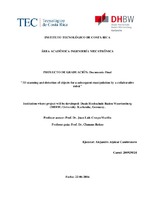Mostrar el registro sencillo del ítem
3D scanning and detection of objects for a subsequent manipulation by a collaborative robot
| dc.contributor.author | Alpízar-Cambronero, Alejandro | |
| dc.date.accessioned | 2017-04-04T16:30:38Z | |
| dc.date.available | 2017-04-04T16:30:38Z | |
| dc.date.issued | 2016 | |
| dc.identifier.uri | https://hdl.handle.net/2238/6937 | |
| dc.description | Proyecto de Graduación (Licenciatura en Ingeniería en Mecatrónica) Instituto Tecnológico de Costa Rica, Área Académica de Ingeniería en Mecatrónica, 2016. | es |
| dc.description.abstract | The present document is a brief description of what the project "3D scanning and detection of objects for a subsequent manipulation by a collaborative robot" will be about, and how the solution will be approached. The project is developed as a final requirement to obtain the degree of "Licenciatura" in Mechatronic Engineering at the Tecnológico de Costa Rica. On the first part, the context of the project will be presented. It will be introduced different applications for 3D mapping technologies that can be found nowadays, as well as the different algorithms that are commonly used in this type of applications. It will be presented an outlook of some of the obstacles that might occur when handling this type of technology, and also the main authors and documents that were used to build a prospect of the realization of the project. On the consequent part, it will be defined the problem to be resolved, with the environment where it will be developed. Also, the main problem will be divided in several steps, to facilitate the achievement of the overall project. Finally, it will be presented the motivation for the interested part to develop a project of such nature. The next section will describe a strategy proposed to approach a solution for the entire project. It will be explained in more detail what each stage of the solution consist, and how every one of them is intended to be resolved. Ishikawa diagrams will be used as a tool to identify different problems present on the work, and the possible root causes that may be inducing each problem. After this, the Objectives section will present both the general and specific objectives for this project, together with a specific indicator for each objective. In the "Project execution" section, it will be detailed a list of steps to realize, to achieve the goals of the project. After this, a Gantt Diagram will be presented as an approximate to distribute time efficiently for the project. After this, a small summary of the expenses of the project will be presented, to understand the impact and feasibility of the project. 10 On the Solution's detailed description section, it will be described with detail all the steps that were taken to develop the project and to achieve the desired objectives. This section will be sub-divided to present the solution for each phase independently, with a final integration phase that connects all the solutions developed. After presenting the solutions developed, an analysis section will be described, where the strengths and weaknesses of the project will be described. Followed by this section, the conclusions of the project will be stated and after this, it will be presented a section that mentions different recommendations and future work that can be developed after this project, to give continuity and achieve more goals on the future. Finally, it will be presented a list of the sources and authors used to develop this document, as well as the important documents in the corresponding Appendix section. | es |
| dc.description.sponsorship | Duale Hochschule Baden Wuertemberg (DHBW) University | es |
| dc.language.iso | spa | es |
| dc.publisher | Instituto Tecnológico de Costa Rica | es |
| dc.rights | acceso abierto | es |
| dc.subject | Soluciones | es |
| dc.subject | Mapeo | es |
| dc.subject | Algoritmos | es |
| dc.title | 3D scanning and detection of objects for a subsequent manipulation by a collaborative robot | es |
| dc.type | proyecto fin de carrera | es |


